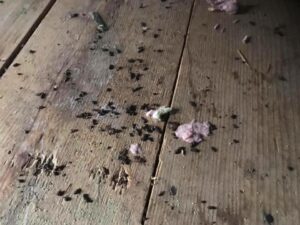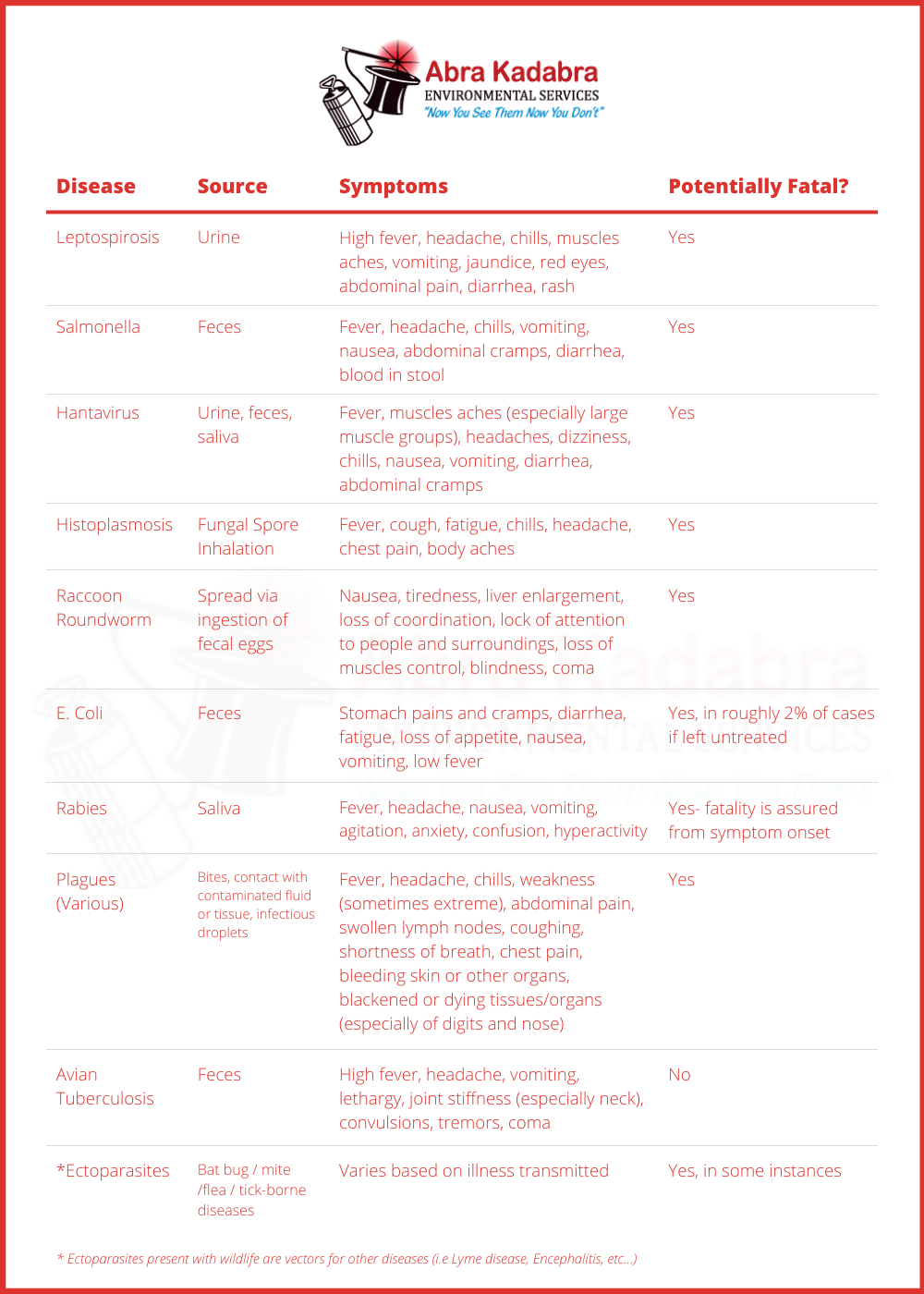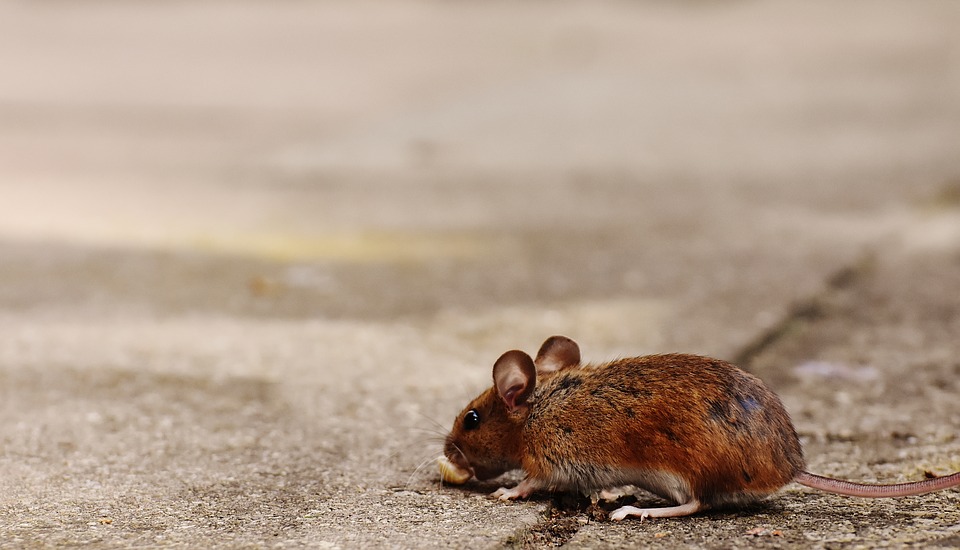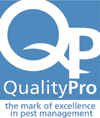One of the scariest things you learn in the pest & wildlife industry is how many ways exposure to wildlife and their waste products can sicken or even kill you.
 It sounds like an alarmist statement, but it is accurate. Mishandling of either can have serious consequences for one’s health. Most of us have taken for granted that it is not a big deal to clean rodent or bird droppings, but the risks are very real.
It sounds like an alarmist statement, but it is accurate. Mishandling of either can have serious consequences for one’s health. Most of us have taken for granted that it is not a big deal to clean rodent or bird droppings, but the risks are very real.
The big threat, when it comes to wildlife, is zoonoses, or zoonotic diseases. Zoonotic diseases are infectious diseases transmitted from animals to humans. This introduces a new disease to humans and is inherently dangerous. Our lack of experience with new diseases makes natural immunity and effective treatment difficult. These diseases can be bacterial, viral, parasitic or sometimes fungal with the modes of transmission equally wide ranging.
The method of transmission for a pathogen is highly relevant to this discussion. Some zoonotic diseases are spread by inhalation, while others infect you through ingestion of contaminated food or water, mucous membranes, damaged skin (including micro cuts), and bites.
Knowing what the risks are and mitigating them through use of proper PPE and safety protocols is vital when handling wildlife issues. Knowing what exposure risks exist can also aid your doctor in diagnosing illness, should anyone become ill.
Common Local Wildlife & Associated Dangers:
Mice/Rats: Hantavirus, Leptospirosis, Lymphocytic Choriomeningitis (LCM), Tularemia, Salmonellosis, Rabies, Plague, Rat-Bite Fever, Ectoparasites
Bats: Histoplasmosis, Rabies, Ebola, Coronaviruses (COVID-19, SARs, etc…), Salmonellosis, Yersiniosis, Nipah Virus, Hendra Virus, Ectoparasites
Birds: Avian Tuberculosis, Erysipelas, Ornithosis, Cryptococcosis, Salmonellosis, Cryptosporidiosis and Campylobacterosis
Raccoons: Raccoon Roundworm (Baylisascaris procyonis), Rabies, Distemper, Leptospirosis, Giardiasis, E. Coli, Ectoparasites
Squirrels: Leptospirosis, Tularemia, Rabies, Salmonellosis, E. Coli, Ectoparasites
This list of diseases for the above wildlife is not all encompassing, but it is a highlight of some of the more common dangers. As most people are not well versed on most of these diseases, here is a brief comparison of symptoms for some of the diseases above:

Clearly there is significant symptom overlap between these diseases, far too many of which resemble other more common illness symptoms. It is presumed that many non-lethal human infections are misdiagnosed as common illnesses or never reported. Some diseases, however, are quite evident when an outbreak occurs and are capable of sparking a pandemic (for example, COVID-19, Ebola, the plague).
Animal Waste Cleanup & Disinfection
Each type of animal waste has unique cleanup needs, and it is important to know what those are before donning PPE and handling it. Raccoon roundworm can only be killed in extreme heat (which is not practical) or mitigated with encapsulation, while bat guano can only be neutralized with formaldehyde (which is illegal to use) or encapsulated. Many other situations can be remediated with proper use of a HEPA vacuum and an industrial disinfectant like DSV.
These varying remediation requirements illustrate the need to know what you’re dealing with before you dive into a DIY solution. The dangers posed by wildlife in your home or yard are more common than most people realize. Taking them seriously can keep these diseases from endangering yourself or your loved ones.
Remember:
DON’T TOUCH:
- Wild animals
- Raccoon latrines
- Bird droppings
- Bat Guano
- Mouse droppings
- Scat, feathers, other biological matter
DO:
- Wash your hands
- Keep children away from wild animals and their waste products
- Wear proper PPE
- Call a wildlife control professional
- Consult your physician
- Take it seriously
 When your home is experiencing a wildlife problem, it is important to have the animals removed and the entry points sealed up (to prevent re-entry) before doing a thorough waste cleanup. At Abra Kadabra, we follow the National Wildlife Control Operator’s Association’s (NWCOA) 4 step process of inspecting, removing, monitoring and repairing. We always confirm the target species and identify the areas of activity and entry points, trap out the animals, then exclude (wildlife proof) the structure.
When your home is experiencing a wildlife problem, it is important to have the animals removed and the entry points sealed up (to prevent re-entry) before doing a thorough waste cleanup. At Abra Kadabra, we follow the National Wildlife Control Operator’s Association’s (NWCOA) 4 step process of inspecting, removing, monitoring and repairing. We always confirm the target species and identify the areas of activity and entry points, trap out the animals, then exclude (wildlife proof) the structure.
Once that is completed we can remove, disinfect, or encapsulate contaminated materials to get rid of dangerous waste products and any pheromones marking prior entry points. Note that disinfectant can be used at the first appointment in situations where the waste is in a high danger area such as a kitchen or child’s room.
Quality Wildlife Removal In Twin Cities
If your home or business is in the Twin Cities area and you are experiencing an issue with wildlife, reach out to our team of Advanced Wildlife Control Technicians today!







